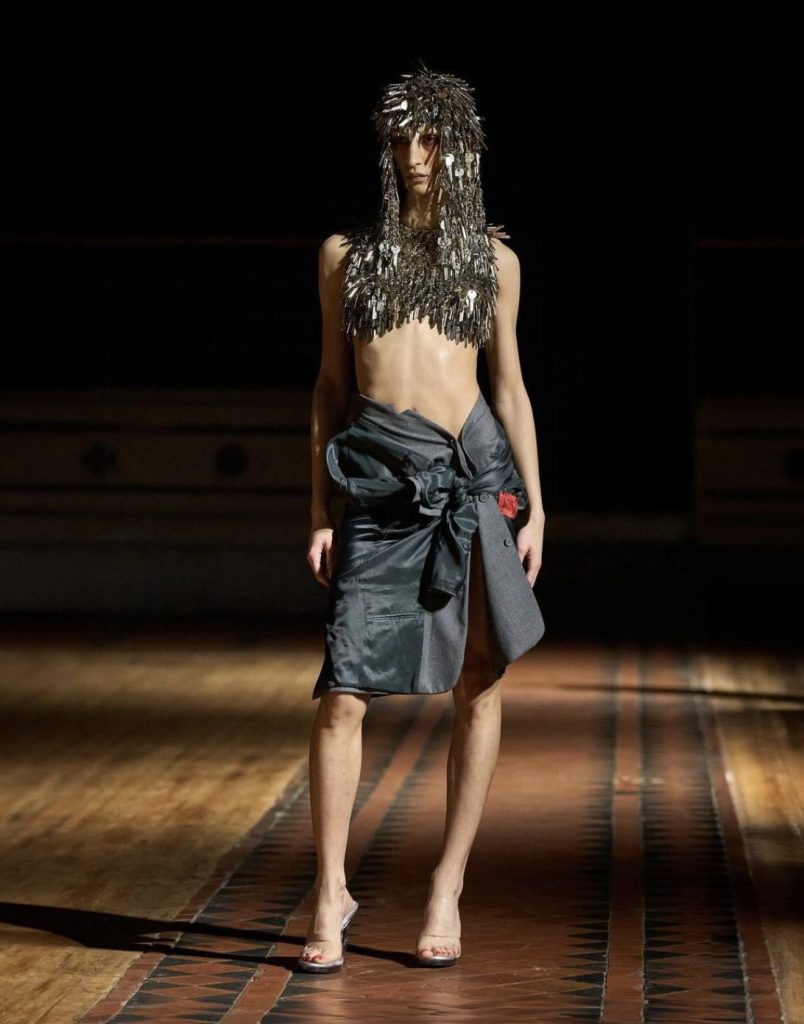This season, the British Fashion Council celebrated the 40th anniversary of London Fashion Week, underscoring London’s pivotal role as the birthplace of exceptional fashion talent. The history of this legendary event is filled with memorable milestones: Alexander McQueen’s iconic “Voss” show in 2001 and striking debut in 1993 and Vivienne Westwood’s participation in the very first lineup in 1984.
The journey also includes the unforgettable runway moments of the now-closed Christopher Kane and the early creative explorations of John Galliano, each contributing to London’s rich fashion narrative. Notably, Hussein Chalayan’s 2010 show, where furniture transformed into dresses, offered a poignant commentary running away in times of war which sadly, is still relevant today.
Yet, as we celebrate this legacy of innovation and creativity, the announcement of the UK’s entry into an economic recession casts a shadow over the festivities. This contrast highlights London Fashion Week’s enduring spirit and vibrancy, a showcase of experimental and lively fashion that continues to captivate and inspire, even in challenging times.
Designers like Erdem and JW Anderson took to nostalgia, each in their own way. Moralioglu found inspiration in Maria Callas’s nomadic life. Staged under Parthenon sculptures in the British Museum, the designer mused about the singer’s nomadic life. The show’s finale featured soprano Nadine Benjamin performing to music composed by James Righton, Erdem’s longtime collaborator.

ERDEM AW24
Meanwhile, fashion’s designer of the moment, Jonathan Anderson, turned to British nostalgia. The collection featured oversized chunky knits, pointelle thermals, English tweeds, and slippers, setting the tone for a series of ‘grandma-esque’ cosy ensembles that conveyed a sort of satire of elderly British villagers.

Burberry Autumn Winter 2024 by Daniel Lee
For Burberry, nostalgia meant sticking to the safe bets with a collection that, while not exactly the season’s highlight, showcased a plethora of desirable brand classics poised to maintain the esteemed status of this iconic British label. The question of whether this approach will significantly boost the brand’s performance remains open. The collection emphasised broad-shouldered, high-collared outerwear, complemented by substantial bags and footwear, alongside generously tailored garments and pronounced layering. In a climate where global luxury is facing a slowdown, one might wonder if there’s any room for creativity to truly make a mark.

Roksanda PAP FW 2024
London Fashion Week February 2024

Roksanda PAP FW 2024
London Fashion Week February 2024
Roksanda, a cherished name in London’s fashion circuit, leaned into her hallmark flair for vibrant hues and hopeful undercurrents this season. Drawing from the quaint charm of Le Corbusier’s 12-square-foot holiday retreat on the Côte d’Azur, her collection mirrored the ‘free-spirited’ vibrancy of his murals. The lineup featured garments that resembled intricate tapestries, incorporating ropes in a creative fashion that adorned ballgowns and elegantly gathered coats. This narrative weaved a tale of understated opulence, marked by a keen eye for structural sophistication.
View this post on Instagram
Molly Goddard delivered a vibrant collection, marked by voluminous silhouettes and bold colours like fuchsia and burgundy, showcasing her mastery in tailoring and layering.
Alice Temperley’s “Metamorphosis” paid tribute to the 1920s high bohemia, drawing inspiration from the era’s lavishness and the Bright Young Things’ exuberance. This collection offered a nostalgic escape, reflecting a blend of historical opulence and contemporary design.
In a continuation of their affinity for darker musings, designers such as Simone Rocha and Dilara Findikoglu delved once more into the shadows for inspiration. Rocha’s “The Wake” stands as the poignant culmination of a narrative trilogy, initiating with “The Dress Rehearsal” and evolving through “The Procession” at Jean Paul Gaultier’s haute couture spectacle. This concluding chapter embarks on an exploration of mourning attire, intricately weaving the dignified grace of the Victorian era into the fabric of modern haute couture.

Simone Rocha AW24

Simone Rocha AW24
Fındıkoğlu’s work, echoing the dramatic flair of Galliano, saw her collaborate with Pat Boguslawski, Galliano’s esteemed movement director, to infuse her show with a theatricality that had models pirouetting in a spectacle of motion. Far from portraying fragile figures, Fındıkoğlu presented a cadre of formidable sirens, adorned in sculptural corsetry, incisive tailoring, and slick panier dresses, all exuding a fierce aura. Amidst whispers of Fındıkoğlu being a frontrunner for the coveted role at Alexander McQueen, the position was ultimately secured by Seán McGirr, adding an intriguing twist to the narrative of fashion succession.

Dilara Findikoglu

Dilara Findikoglu



